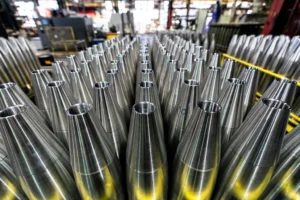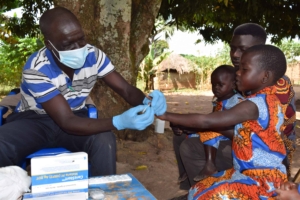
Ninety Percent of Military Aid Goes to Replenish and Modernize U.S. Arsenals
 Foreign aid conjures an image of stacks of dollar bills being shipped to faraway places. In reality, most dollars never leave the United States and instead are used to pay for military equipment manufactured in America.
Foreign aid conjures an image of stacks of dollar bills being shipped to faraway places. In reality, most dollars never leave the United States and instead are used to pay for military equipment manufactured in America.
Of the $24 billion in U.S. military equipment aid approved so far to Ukraine, 90 percent has gone to U.S. weapons manufacturers, according to reporting by The Washington Post.
This isn’t a new trend. For example, the United States has provided foreign aid to Egypt for decades. In Fiscal Year 2020, U.S. military aid to Egypt totaled $1.4 billion, almost all of which went to purchase or maintain military equipment made in the United States.
Replenishing U.S. Military Arsenal
Equipment purchased with Ukrainian military aid is manufactured in 31 states, 71 cities and on 117 separate production lines, concentrated in Pennsylvania, Arkansas, Florida, Alabama, California, Arizona and New Mexico, based on an assessment by the conservative American Enterprise Institute.
 Bradley infantry fighting vehicles come off production lines In York, Pennsylvania and Anniston, Alabama. Howitzers are made in Aiken, South Carolina; Elgin, Oklahoma; Endicott, New York; and Minneapolis. HIMARS systems are built in Peoria, Illinois; Clearwater. Palm Bay and Niceville, Florida; Camden, Arkansas; Lancaster and Grand Prairie, Texas; Rocket Center, West Virginia; and Trenton, New Jersey.
Bradley infantry fighting vehicles come off production lines In York, Pennsylvania and Anniston, Alabama. Howitzers are made in Aiken, South Carolina; Elgin, Oklahoma; Endicott, New York; and Minneapolis. HIMARS systems are built in Peoria, Illinois; Clearwater. Palm Bay and Niceville, Florida; Camden, Arkansas; Lancaster and Grand Prairie, Texas; Rocket Center, West Virginia; and Trenton, New Jersey.
Similar lists of cities connect with manufacturing of Javelin antitank missiles, Hydra-70 rockets and spare parts, computer chips, night-vision gear and munitions. Workers are on the job because of U.S. foreign aid for Ukraine that goes first through American production lines. One Ukrainian official said every state is contributing to the fight through workers on production lines.
What has been physically sent to Ukraine tend to be stockpiled weapons. The United States has sent 1,400 Stinger antiaircraft missiles to Ukraine. Until those missiles were pulled out of mothballs, the United States hadn’t manufactured a new one since 2005. The Pentagon issued a $624 million contract last year to build 1,400 replacements in Tucson, Arizona. The money came from military aid to Ukraine.
Another $600 million in Ukrainian military aid was used to build two advanced weapons systems in St. Charles, Missouri. A different contract put workers in West Plains, Missouri on production lines to make radar capable of downing Russian hypersonic missiles.
 The overlooked and unspoken rationale for military aid to Ukraine is to revitalize the U.S. defense industrial base. Before aid was sent to Ukraine, the United States was producing roughly 15,000 artillery shells per month. Ukrainian soldiers fire between 6,000 and 8,000 a day.
The overlooked and unspoken rationale for military aid to Ukraine is to revitalize the U.S. defense industrial base. Before aid was sent to Ukraine, the United States was producing roughly 15,000 artillery shells per month. Ukrainian soldiers fire between 6,000 and 8,000 a day.
Now, Ukrainian military aid will boost U.S. production to 100,000 per month in two Pennsylvania cities and a new factory in Arkansas. The explosives, fuses and shell bodies going into those weapons will be manufactured in cities in Tennessee, Iowa and California. A new factory in Mesquite, Texas will employ 125 workers and produce 20,000 artillery shells per month.
The weapons being purchased to replace older ones sent to Ukraine will help refresh and modernize American weapon stockpiles.
Boost for U.S. Arms Sales
U.S. military aid to Ukraine has been joined by NATO allies who are emptying their stockpiles of older weapons. Poland has given Ukraine its Soviet-era equipment while signing contracts to buy modern U.S. tanks made in Lima, Ohio and attack helicopters produced in Mesa, Arizona.

A similar pattern exists when European countries such as Finland, Norway, Denmark and the Netherlands have donated older jet aircraft to Ukraine and purchased F-35 fighter jets and armaments manufactured across America in California, Iowa, Connecticut, Texas and Arizona.
Critics of sending arms to Ukraine warn it has depleted U.S. weapon inventories. Many of those critics represent states and communities directly benefitting from foreign aid to Ukraine that is being plowed into restoring and strategically upgrading America’s military arsenal.
Washington Post columnist Marc Thiessen wrote, “Our military aid to Ukraine is revitalizing manufacturing communities across the United States, creating good jobs here at home and restoring the United States’ capacity to produce weapons for our national defense. Helping Ukraine is the right thing to do for U.S. national security. It is also the right thing to do for American workers.”
“Our military aid to Ukraine is revitalizing manufacturing communities across the United States, creating good jobs here at home and restoring the United States’ capacity to produce weapons for our national defense.
Foreign Aid Myths
When polled, a majority of Americans believe foreign aid consumes as much as 25 percent of total U.S. outlays. The actual percentage is closer to 1 percent, according to the Brookings Institution.
 It’s true the United States provides the most foreign aid of any country. However, when foreign aid is considered as a percent of gross national product, Norway, Sweden, Luxembourg, Denmark and the U.K. exceed the 0.7 percent benchmark for industrialized nations. The U.S. percentage is 0.2 percent.
It’s true the United States provides the most foreign aid of any country. However, when foreign aid is considered as a percent of gross national product, Norway, Sweden, Luxembourg, Denmark and the U.K. exceed the 0.7 percent benchmark for industrialized nations. The U.S. percentage is 0.2 percent.
Most foreign aid doesn’t go directly to governments. The majority of aid is distributed through multilateral or non-governmental organizations and is heavily monitored by the U.S. Inspector General.
The biggest complaint against foreign aid is that it fails to produce results. Global development data tells a different story:
- Extreme poverty has fallen dramatically over the past 30 years – from 1.9 billion people (36 percent of the world’s population) in 1990 to 736 million (10 percent) in 2015
- Maternal, infant and child mortality rates have been cut in half
- Life expectancy globally rose from 65 years in 1990 to 72 in 2017
- Smallpox has been defeated; polio eliminated in all but two countries; deaths from malaria cut in half from 2000 to 2017
- The U.S. PEPFAR program has saved 17 million lives from HIV/AIDS and enabled 2.4 million babies to be born HIV-free.
Surveys indicate foreign aid overall isn’t popular with Americans, though polls show overwhelming approval for humanitarian assistance such as improving people’s health, helping women and girls, educating children and helping poor countries develop their economies.
More About U. S. Aid to Ukraine
Foreign aid for strategic purposes isn’t universally popular and Americans often overlook domestic benefits, such as the military aid to Ukraine that has created thousands of U.S. jobs and is in the processing of modernizing the U.S. arsenal of national defense.
https://www.cfr.org/article/how-much-aid-has-us-sent-ukraine-here-are-six-chart




